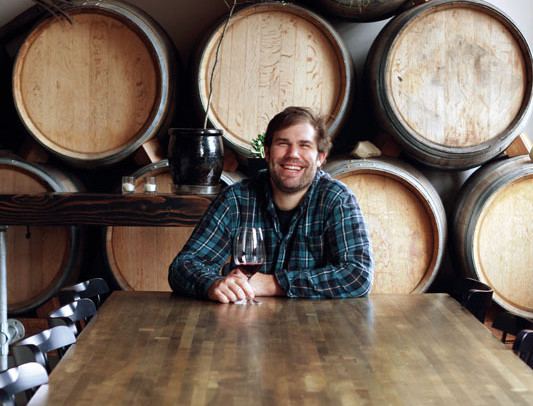Natural Wines at Sauvage

Image: Allison Jones
As a new vintage of urban wineries crops up in Portland, Sauvage at Fausse Piste has captured the zeitgeist with a distinctive flair. The candlelit, barrel-lined Central Eastside space showcases the devil-may-care approach of urban vintners, serving sophisticated small plates while shining a spotlight on the winery’s Rhône-inspired cuvées. Most employees work the dinner line as well as the barrel room.
When he founded the Fausse Piste label in 2008 at age 24, Jesse Skiles was one of Oregon’s youngest winemakers. Complex wines from France’s Rhône Valley provided inspiration, but he fell hard for natural winemaking—without added sugars, yeast, or adjustments for acidity. “At first you think you’re going to ruin everything by not controlling the wine,” remembers Skiles. “Then it turns out so much more beautiful than it had ever been before.”
Despite the growing number of restaurants nationwide that stock Skiles’s wines, Fausse Piste bottles won’t carry a Robert Parker score any time soon. A favorable ranking from the Wine Advocate’s influential writer can make a wine overnight, but Parker favors big, oaky, high-alcohol flavors. “They lose the whole point of what we do,” says Skiles. “Our wines aren’t meant to age. They’re not flashy—but they’re thoughtful and personal.” In that spirit, Skiles shares the stories behind the Fausse Piste wines available this month at Sauvage.
2010 La Pyramide Syrah
“A multivineyard blend of cofermented syrah and viognier, this is a true Rhône-style wine I’ve wanted to do since we started. With all neutral oak barrels aged an extra year prior to bottling, only the fruit comes through, nothing else. It takes a few months in bottle to come together, but when it does, it has a polished forgiveness to it.”
2011 The Mineral Selection Viognier
“This wine requires special protection from the elements, or it can develop a sunburnt bitterness, but that safeguard can sacrifice complexity. We’ve increased the amount of skin contact to replace some of that structure, and use concrete, acacia, and stainless steel fermenters to preserve the fruit’s lemon rind character.”
2011 L’Ortolan Roussanne
“Our roussanne comes from less than an acre on the high-elevation Outlook Vineyard in the Yakima Valley. Because we only have a tiny, handpicked amount to work with every year, we decided to experiment with natural winemaking in a traditional cask. The result, this wine, was a turning point for us.”
2010 Riverrock Vineyard Syrah
“These grapes come from two acres on the Oregon side of the Walla Walla. It’s an old, cobblestone riverbed that always freezes in the early winter. The vineyards are borderline dead, you have to start over every year, and the yields are terrible. But it’s worth it: the wines have a smoky gaminess that doesn’t come from oak—it comes from the struggle.”
